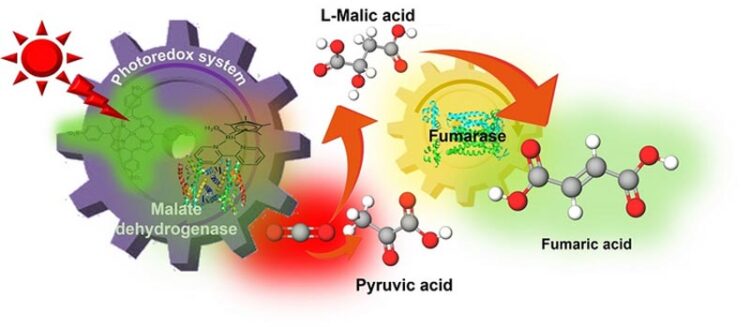Artificial photosynthesis uses sunlight to make biodegradable plastic

Using sunlight to power the photoredox system pyruvic acid and CO¬2 are converted into fumaric acid, by malate dehydrogenase and fumarase.
Credit: Yutaka Amao, Osaka Metropolitan University
Synthesis of fumaric acid by a new method of artificial photosynthesis, using sunlight.
In recent years, environmental problems caused by global warming have become more apparent due to greenhouse gases such as CO2. In natural photosynthesis, CO2 is not reduced directly, but is bound to organic compounds which are converted to glucose or starch. Mimicking this, artificial photosynthesis could reduce CO2 by combining it into organic compounds to be used as raw materials, which can be converted into durable forms such as plastic.
A research team led by Professor Yutaka Amao from the Research Center for Artificial Photosynthesis and graduate student Mika Takeuchi, from the Osaka Metropolitan University Graduate School of Science, have succeeded in synthesizing fumaric acid from CO2, a raw material for plastics, powered—for the first time—by sunlight. Their findings were published in Sustainable Energy & Fuels.
Fumaric acid is typically synthesized from petroleum, to be used as a raw material for making biodegradable plastics such as polybutylene succinate, but this discovery shows that fumaric acid can be synthesized from CO2 and biomass-derived compounds using renewable solar energy.
“Toward the practical application of artificial photosynthesis, this research has succeeded in using visible light—renewable energy—as the power source,” explained Professor Amao. “In the future, we aim to collect gaseous CO2 and use it to synthesize fumaric acid directly through artificial photosynthesis.”
About OMU
Osaka Metropolitan University is a new public university established by a merger between Osaka City University and Osaka Prefecture University in April 2022. For more science news, see https://www.omu.ac.jp/en/, and follow @OsakaMetUniv_en, or search #OMUScience.
Journal: Sustainable Energy & Fuels
DOI: 10.1039/D2SE01533A
Method of Research: Experimental study
Subject of Research: Not applicable
Article Title: Visible-light driven fumarate production from CO2 and pyruvate by the photocatalytic system with dual biocatalysts
Article Publication Date: 13-Dec-2022
Media Contact
Akane Kunida
Osaka Metropolitan University
koho-ipro@ml.omu.ac.jp
Original Source
All latest news from the category: Ecology, The Environment and Conservation
This complex theme deals primarily with interactions between organisms and the environmental factors that impact them, but to a greater extent between individual inanimate environmental factors.
innovations-report offers informative reports and articles on topics such as climate protection, landscape conservation, ecological systems, wildlife and nature parks and ecosystem efficiency and balance.
Newest articles

Innovative 3D printed scaffolds offer new hope for bone healing
Researchers at the Institute for Bioengineering of Catalonia have developed novel 3D printed PLA-CaP scaffolds that promote blood vessel formation, ensuring better healing and regeneration of bone tissue. Bone is…

The surprising role of gut infection in Alzheimer’s disease
ASU- and Banner Alzheimer’s Institute-led study implicates link between a common virus and the disease, which travels from the gut to the brain and may be a target for antiviral…

Molecular gardening: New enzymes discovered for protein modification pruning
How deubiquitinases USP53 and USP54 cleave long polyubiquitin chains and how the former is linked to liver disease in children. Deubiquitinases (DUBs) are enzymes used by cells to trim protein…



